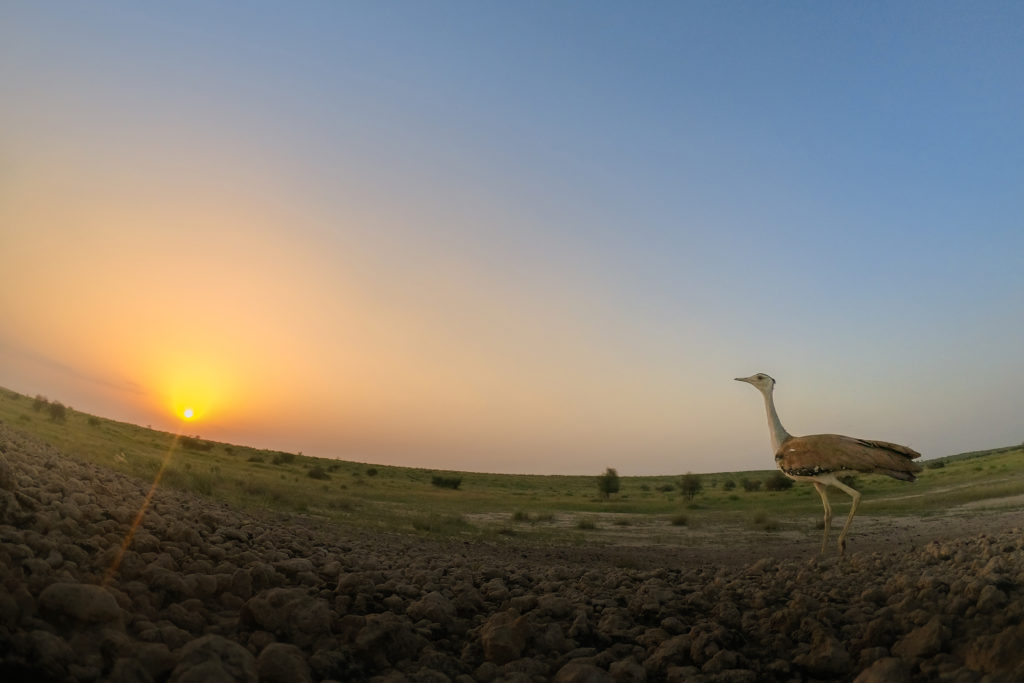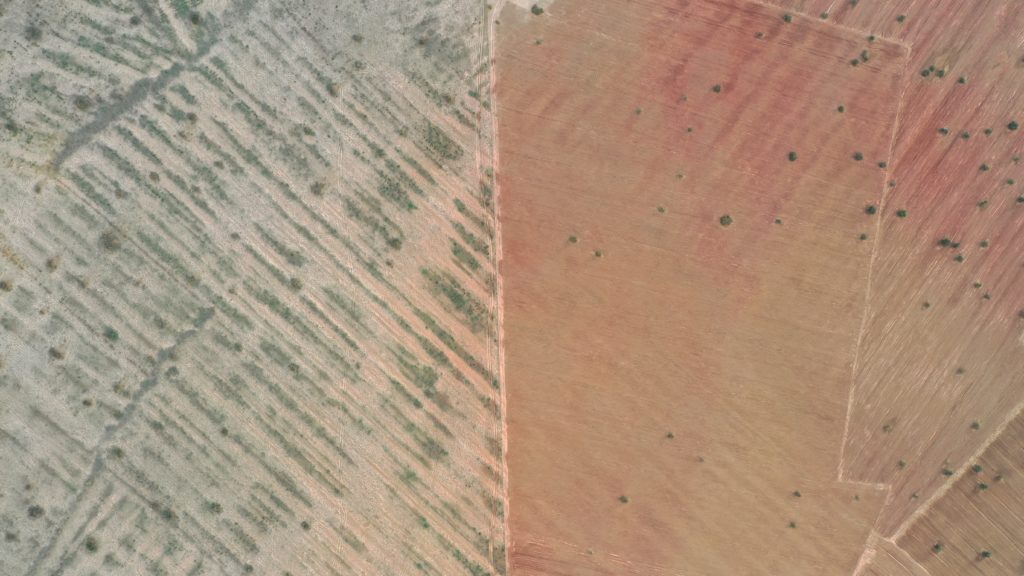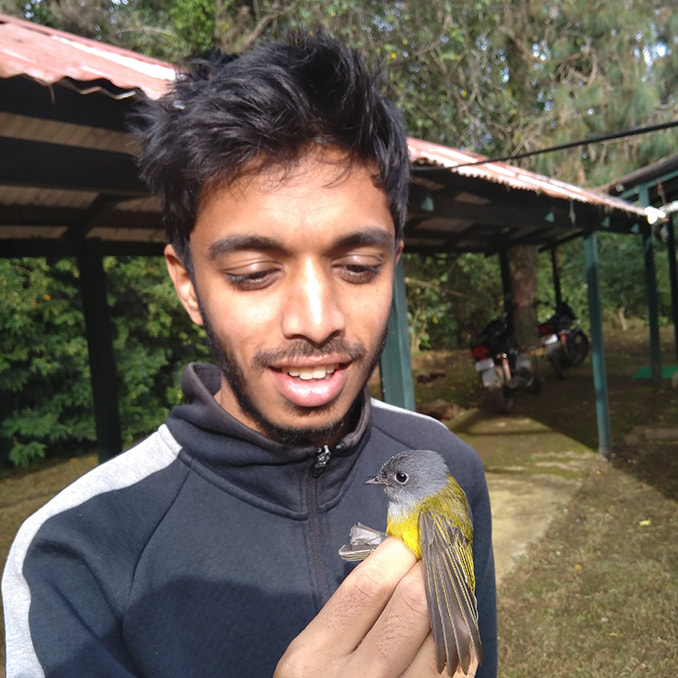Fieldwork on birds has always been exciting, but never more than the time when we were tagging the first set of Great Indian Bustards (GIBs) in the Thar desert. It was the summer of 2019, I was just finishing my Master’s dissertation on desert birds, and Dr. Sutirtha Dutta’s Bustard Recovery Program team from WII (Wildlife Institute of India) had just started their efforts to tag the first Great Indian Bustards in Rajasthan. The process was plain and simple: find the bird, identify its preferred route, lay noose traps on a suitable movement path, catch the bird, put a transmitter on its back and release it after tagging. The only difficulty was that bustards range far and wide, and finding their movement paths in the expansive desert was an extremely challenging task. It took 10-15 days of continuous observation and the field team’s amassed experience to finally find a suitable location to lay the traps. The area was an interdunal valley with dunes and hillocks to the north and east, wide expanse of a protected grassland to the west and fallow agricultural fields with a tall house to the south. The birds were regularly coming from the distant dunes to forage in the grasslands and the fields. The trapping location was decided….
D-day, nooses were laid right at the crack of dawn and monitoring teams were stationed at strategic locations to keep a watch on the birds: one team on a small hillock, one inside a traditionally made hide, one on top of a tower/terrace, and the tagging team stood ready inside the field vehicle. And then started a long wait. The location looked exceptionally empty and devoid of the usual activity. The GIBs had decided to give their favourite breakfast joint a miss. Come afternoon, we were burning in 50 degrees of desert heat, eyes tired from scanning the area for birds. Excitement of fieldwork was slowly getting replaced by the boredom of a long wait.
 Deserts are expansive landscapes. With a scope and some practice, one can observe large birds from more than a kilometre. The photo shows the landscape where the traps were laid.
Deserts are expansive landscapes. With a scope and some practice, one can observe large birds from more than a kilometre. The photo shows the landscape where the traps were laid.
As the afternoon passed by, the temperatures dropped and we finally saw our usual suspects come towards us from their favoured resting site, from beyond the dunes. They followed their daily routine and started coming closer to the traps. And just when they were about to reach the traps, they stopped and started foraging a few metres away. The next few minutes were nerve-racking and so silent that we could have even heard a pin drop. Everyone was ready with their tasks, all scopes were pointed at the birds to track their every single movement, the tagging team was ready in the vehicle to make their 500m dash. About ten minutes later, one of the observers shouted “Caught, Caught, Caught…” What happened next is more of a blur – I remember the tagging team rushing towards the bird and the other teams watching them in the fading light. Finally, just as the sun went below the horizon, one of the birds was successfully tagged with a GPS-GSM transmitter and released. This young bird, a female, has since given us numerous novel insights into GIB behaviour and ecology. More tagging episodes have followed in the ensuing years and all of them have been memorable; but this one remains firmly rooted in my mind.
 A Great Indian Bustard, almost a metaphor to the fate of India’s dryland habitats, with an impending sunset (or perhaps a sunrise?)
A Great Indian Bustard, almost a metaphor to the fate of India’s dryland habitats, with an impending sunset (or perhaps a sunrise?)
This is how my love for birds (and research) took shape..
My first exposure to birds was during a birding/nature camping trip to Dandeli-Anshi in 2012, right after my 10th standard exams. We had two excellent birders guiding us there and they had shown us some really cool birds in the five days. I was very intrigued to see an actual forest for the first time and was particularly astounded by the dark evergreens of Anshi. Everything from the tall trees, the birds, the herps, to the intermittent silence was very exciting and was unlike anything that I had experienced before. It was an exciting sensitisation to the natural world for me.
After getting interested in nature, I started roaming around Pune (my hometown) for birds and herps; and came in contact with many students studying ecology in various colleges of Pune (particularly the Biodiversity Department in Garware College). I also started conducting nature education camps with an eco-tourism organisation (Insearch Outdoors) in Pune. One fine day, the Director of this organisation, Mr. Shauri Sulakhe, asked me if I would be interested in helping his student collaborator study the behaviour of an endangered toad species in Sahyadri Tiger Reserve in Maharashtra. I had just enrolled for a B.Sc Zoology from Fergusson College in Pune, was very interested in amphibians, and instantly said yes. The next two monsoons (my first and second years of B.Sc, 2015-16) were spent looking for amphibians in the northern Western Ghats with various research teams working out of Pune. During this time, I met many interesting researchers (Ashish Nerlekar, Vedant Dixit, Pushkar Phansalkar and Pratik Joshi, to name a few) and they ensured that my curiosity turned into a more structured academic focus. To top it all, I was lucky to get a summer internship at IISER Trivandrum, where I worked with a doctoral student, Vivek Philip Cyriac, who was an amazing mentor and ensured that I learned the basics of research the right way. I subsequently got an opportunity to do my Masters at the Wildlife Institute of India in the XVIth Wildlife Science M.Sc Batch (2017-19). Describing the two years of M.Sc at WII is beyond my literary capabilities (and the word limit for this article) – I learnt to find and read the right books, wrote my first original page of english prose, thought about plants and many other things that I was earlier totally uninterested in, walked hundreds of kilometres in some of the best landscapes in India, saw some magnificent birds, I can go on and on…..
I am currently working as a researcher at the Wildlife Institute of India’s Bustard Recovery Program, where my work involves conducting field research, coordinating conservation activities and crunching/analysing a lot of data. I am actively involved in various applied research components of the program, including telemetry, population ecology and behavioural study of the Great Indian Bustards; habitat improvement and stakeholder engagement for participatory management of GIB areas; and monitoring of bustards and other associated dryland fauna. Apart from my work on Bustards, I also survey small bird populations in the Thar Desert (and other adjoining areas), in close collaboration with the arid zone Bird LTEO program team.
Of late, I have also developed a keen interest in grassland restoration and am setting up bird monitoring plots in the Desert National Park WLS to understand their responses to vegetation recovery. Academically, most of what I currently do is aimed at understanding how variations in habitat and climate affect the ecology of birds in arid-semi arid landscapes of India. Apart from birds, I also work on other model systems, mainly mammals, with similar questions. Outside this main theme of work, I am generally interested in various aspects of grassland/savanna ecology, bird biogeography and conservation biology. I conduct most of my research in the Thar desert, and spend most of my time doing fieldwork in Desert National Park WLS and adjoining areas of the Jaisalmer district. In the upcoming days, I hope to expand my work beyond Jaisalmer and study birds in dryland areas of Gujarat, Rajasthan and Maharashtra as well.
 The desert is a mosaic of rangelands, croplands and other land-uses. With the climate warming, it is necessary to know how these landscape features affect biodiversity.
The desert is a mosaic of rangelands, croplands and other land-uses. With the climate warming, it is necessary to know how these landscape features affect biodiversity.
I like what I do because….
Fieldwork/data-collection in winter is the most enjoyable part of my current work. The Thar desert is very pleasant during the winter and full of migratory birds! An evening of watching desert birds and then a horizon-touching sunset is my everyday routine, and I absolutely love it. A close second is reading up on interesting books (sometimes papers) and analysing the data that is so painstakingly collected in the field. I also enjoy exploring new areas, and meeting interesting people and birds who live there.
The challenges I faced..
The biggest challenge so far has been dealing with long bureaucratic delays and complex (and often unnecessary) paperwork before starting any actual research work. Another challenge, particularly post-covid, has been the delays in fund disbursements, which has often stopped/slowed work at critical times. A more general problem has been convincing people (including academics and administrators) that ecological research is not merely a hobby or some form of recreation.
My advice to young researchers is..
It seems hard to provide advice but I can probably share some things that have gone well for me so far and few things that haven’t; these might contain some recommendations as well. But with a statutory warning – I only have three years of formal and five years of informal experience in the research field – so please take my words with great caution 🙂
- I have been lucky in terms of getting exposed to (bird) research happening in a variety of ecological and scientific landscapes: Observing birds and research in different places has helped broaden my ideas and opened up new lines of thinking. In short, explore as many regions and institutions/organisations as possible and collect good things from each.
- Similarly, doing various kinds of (bird) research has helped in understanding my study systems more holistically. For example, handling birds for a biogeography research has given me more clarity on approaching many population and community ecology questions that I am interested in.
- I strongly believe that one should not be a one-taxon specialist. Having natural history knowledge of diverse groups (plants/habitat especially) can really help a field biologist in asking more interesting questions and answering them.
- [Personal opinion] The broad purpose of research, I believe, is to answer inherent curiosities and/or to identify and solve problems/knowledge-gaps. I often feel that (ecology) academia takes answering questions too lightly and publishing papers too seriously. I hope to see an academic world where papers/publications are a byproduct, and not the goal, of research. I feel that such a world might be much less stressful and would fuel more innovation and creativity.
- Ornithology or otherwise, please take care of physical and mental health. Fieldwork can often be taxing and isolating, and being healthy should be a priority. Don’t feel shy to take medical help when required.
Varun Kher
[email protected]
Bustard Recovery Program,
Wildlife Institute of India, Dehradun
Twitter: @varun_kher


Excellent…keep up the good work.. and all the best for future endeavors 😀